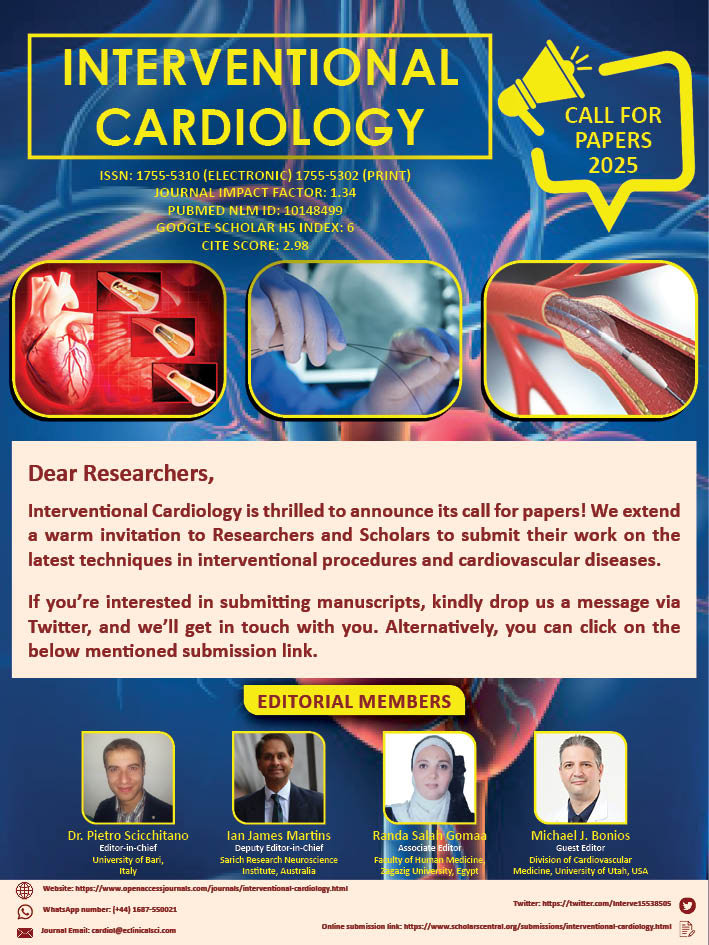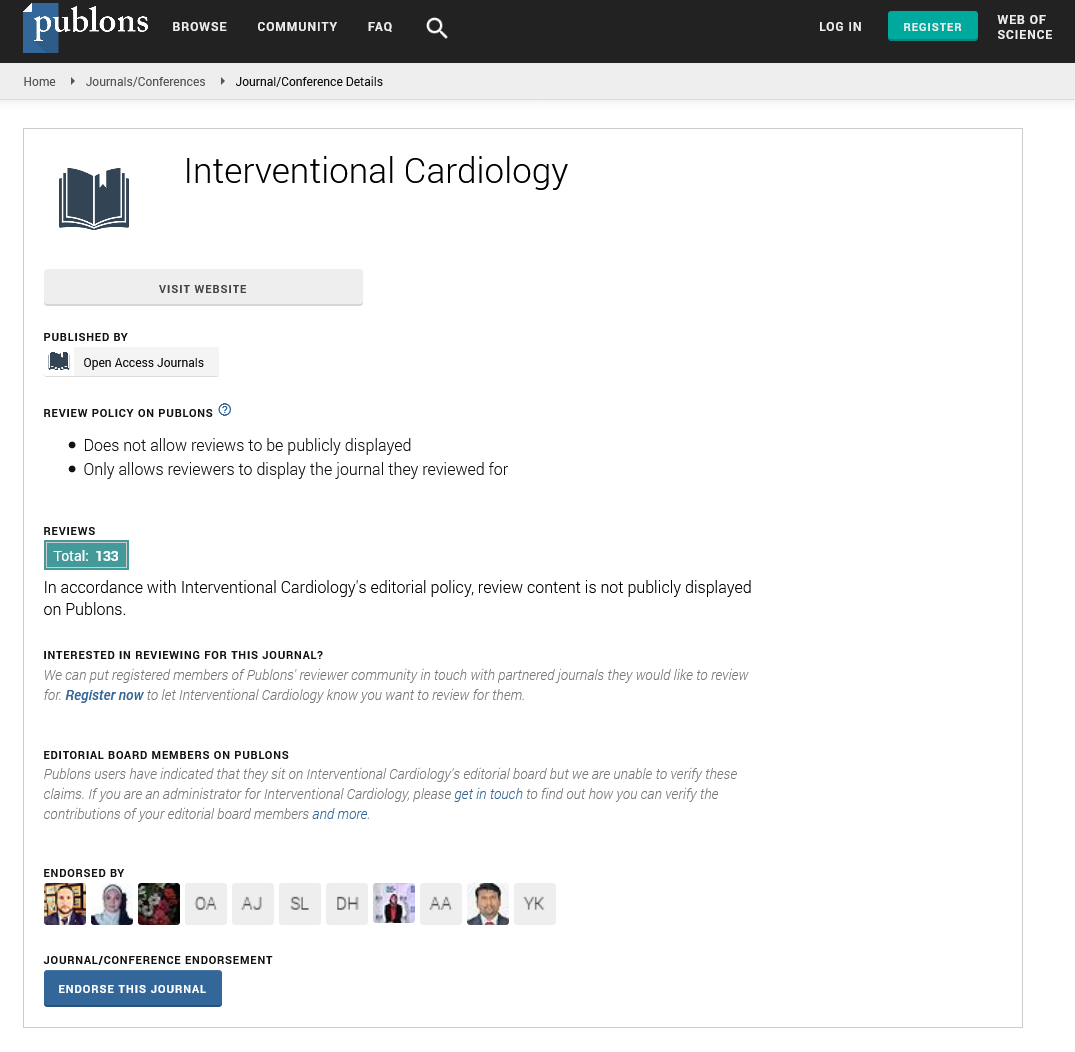Short Communication - Interventional Cardiology (2025) Volume 17, Issue 2
TRASCATHETER AORTIC VALVE IMPLANTATION IN PURE AORTIC REGURGITATION. Promising left ventricular remodeling data
- Corresponding Author:
- Sonia Antoñana Ugalde
Servicio de Cardiología, Hospital Universitario Ramón y Cajal, Madrid, Spain
E-mail: soniaantonana2d@gmail.com
Received date: 03-Mar-2025, Manuscript No. FMIC-25-165586; Editor assigned: 05-Mar-2025, PreQC No. FMIC-25-165586 (PQ); Reviewed date: 19-Mar-2025, QC No. FMIC-25-165586; Revised date: 26-Mar-2025, Manuscript No. FMIC-25-165586 (R); Published date: 02-Apr-2025, DOI: 10.37532/1755-5310.2025.17(2).979
Description
Native Aortic Regurgitation (AR) affects 8%-13% of patients with valvular heart disease. It is the third most common left valvular heart disease after Aortic Stenosis (AS) and Mitral Regurgitation (MR) [1]. Until today, surgical valve replacement has been the standard of care when treating pure symptomatic severe AR or asymptomatic AR if left ventricular systolic dysfunction was present [2]. Valve-sparing techniques could be considered in experienced high-volume centers. However, AR is a degenerative disease, and patients tend to be older and with greater comorbidities when symptoms arise, often in the presence of left ventricular dilatation. Surgical intervention must therefore be discarded due to unacceptable surgical risk, leaving untreated a condition with great impact on morbidity and mortality. It is thought that less than 20% of patients with severe AR and Left Ventricular Ejection Fraction (LVEF) 30%-50% undergo surgery, with even lower percentages when the LVEF drops below 30%.
The development of minimally invasive strategies for the treatment of aortic valve disease in older and more complex patients has been of great interest. Transcatheter Aortic Valve Replacement (TAVR) is a reality when dealing with Aortic Stenosis (AS), but it has also expanded into other scenarios such as degenerated surgical or transcatheter bioprosthesis. Its use is still off-label in native AR due to hemodynamic and anatomical particularities among this population, accounting for as little as 1.4% of the total number of TAVR procedures. The PANTHEON study (Performance of Currently Available Transcatheter Aortic Valve Platforms in Inoperable Patients with Pure Aortic Regurgitation of a Native Valve) is, to date, the largest and most robust real-world registry for the use of available transcatheter heart valves in the setting of native AR [3]. It shows how TAVR for pure AR remains technically challenging with current valves mainly due to higher rates of embolization (12.4%) and paravalvular significant regurgitation (9.6%).
Differences within the natural history of these two entities (AR and AS) may help explain these outcomes [4]. Chronic severe AR does not sit on heavily calcified leaflets that usually act as anchoring structures for the transcatheter valve, either balloon- expandable or self-expandable. Moreover, severe AR and a bicuspid aortic valve are often related. Bicuspid valve anatomy can be part of a more complex aortopathy syndrome, and patients often present with annular or supra-annular aortic dilation, which adds to the technical complexity of the procedure. Permanent pacemaker implantation is also higher. There are no randomized controlled trials comparing Surgical Aortic Valve Replacement (SAVR) vs. TAVR. As far as we know, TAVR for AR with non-specific valves is feasible but has suboptimal outcomes. This justifies that, to date, published data focuses mainly on anatomical and technical aspects [5]. But little is known about how this percutaneous valve replacement affects left ventricular remodeling. AR results in left ventricular volume overload and subsequent heart remodeling with progressive ventricular dilatation and dysfunction. Load- dependent ventricular hemodynamics improve early after surgery and are expected to do so in the same way after a percutaneous intervention in patients not deemed suitable for a conventional surgical approach [6]. Graziani and colleagues demonstrated an immediate significant reduction in Left Ventricular (LV) size (Left Ventricular End-Diastolic Diameter (LVEDd): 60.0 ± 8.0 mm vs. 54.6 ± 8.1 mm; p=0.002; LV end-diastolic volume index 87.1 ± 30.8 mL/m2 vs. 71.4 ± 25.6 mL/m2; p<0.001) and LV mass in 22 patients with severe AR and TAVR for high surgical risk [7].
We have recently published our data, consistent with previous papers, where a significant decline in absolute and indexed end- diastolic and end-systolic diameters and volumes was observed in 21 patients treated with TAVR for symptomatic severe AR [8]. Although our findings were limited by the small sample size and missing data, preliminary echocardiographic assessments including 3-dimensional measurements and Global Longitudinal Strain (GLS) suggest a trend toward favorable ventricular remodeling.
In patients with AR, ventricular dilation can result in increased wall stress and subclinical dysfunction, even in the absence of overt myocardial impairment. Therefore, it has been proposed that combining strain data with dimensional indices such as the GLS indexed to LV End-Diastolic Diameter (GLS/LVEDd) may offer a more accurate reflection of myocardial performance in these patients [9].
The Trilogy transcatheter heart valve (JenaValve Technology, Irvine, CA, USA) has been specifically designed for the treatment of native aortic regurgitation, representing a significant step forward in overcoming the anatomical and technical challenges of this population. This supra-annular prosthesis features three radiopaque locators that enable alignment with the native aortic cusps, allowing for anchoring in the absence of annular calcification. Early clinical experiences have shown favorable safety profiles and promising procedural outcomes. In the pivotal ALIGN-AR trial, the Trilogy system demonstrated high procedural success and a significant reduction in left ventricular mass and end-diastolic diameter, suggesting a positive impact on ventricular remodeling [10]. Furthermore, Tsai et al. conducted a detailed quantitative aortography analysis that confirmed the effective expansion and anchoring of the device, with good hemodynamic performance in both aortic regurgitation and stenosis cases [11]. Additional reports have supported these findings: Yokoyama et al. described successful compassionate use of the Trilogy system in high-risk patients [12], and Baumbach et al. provided a comprehensive review of the valve's design and early clinical results, highlighting its potential as a dedicated solution for pure AR [13]. These data support the hypothesis that the availability of purpose-built devices such as Trilogy may enable safer and more effective TAVR in this challenging subset of patients.
Conclusion
In summary, although the surgical approach remains the standard of care for patients with severe AR, TAVR has emerged as a feasible alternative in selected high-risk or inoperable patients. Early experiences with non-dedicated transcatheter valves have highlighted significant procedural challenges and suboptimal outcomes due to anatomical complexity and lack of calcific anchoring. However, the development of dedicated devices may yield better outcomes. Initial data also suggest that TAVR may promote favorable left ventricular remodeling, although current evidence is limited and based on small observational series. Larger prospective studies are needed to better define the clinical benefits, durability, and optimal patient selection criteria for TAVR in severe AR.
References
- Iung B, Baron G, Butchart EG, et al. A prospective survey of patients with valvular heart disease in Europe: The euro heart survey on valvular heart disease. Eur Heart J. 24(13):1231-1243 (2003).
- Vahanian A, Beyersdorf F, Praz F, et al. 2021 ESC/EACTS Guidelines for the management of valvular heart disease. Eur Heart J. 43(7):561-632 (2022).
- Poletti E, De Backer O, Scotti A, et al. Transcatheter aortic valve replacement for pure native aortic valve regurgitation: The PANTHEON international project. JACC Cardiovasc Interv. 16(16):1974-1985 (2023).
- Vora AN, Sreenivasan J, Forrest JK, et al. Progressing forward in transcatheter aortic valve replacement for pure aortic regurgitation. JACC Cardiovasc Interv. 16(16):1986-1989 (2023).
- Noble S, Mauler-Wittwer S. TAVR as an alternative to SAVR for pure native aortic regurgitation. Can J Cardiol. 40(2):316-325 (2024).
- Murashita T, Schaff HV, Suri RM, et al. Impact of left ventricular systolic function on outcome of correction of chronic severe aortic valve regurgitation: Implications for timing of surgical intervention. Ann Thorac Surg. 103(4):1222-1228 (2017).
- Graziani F, Mencarelli E, Burzotta F, et al. Early hemodynamic and structural impact of transcatheter aortic valve replacement in pure aortic regurgitation. JACC Cardiovasc Interv. 13(21):2582-2584 (2020).
- Ugalde SA, MartÃn AG, Tahoces LS, et al. Reverse ventricular remodeling after transcatheter aortic valve implantation in pure aortic regurgitation. Rev Esp Cardiol (Engl Ed).
- Bartkowiak J, Agarwal V, Lebehn M, et al. Strain assessment in patients with aortic regurgitation undergoing transcatheter aortic valve implantation: Case series. Eur Heart J Case Rep. 8(8):ytae261 (2024).
- Vahl TP, Thourani VH, Makkar RR, et al. Transcatheter aortic valve implantation in patients with high-risk symptomatic native aortic regurgitation (ALIGN-AR): A prospective, multicentre, single-arm study. The Lancet. 403(10435):1451-1459 (2024).
- Tsai TY, Elzomor H, Wienemann H, et al. Quantitative aortography analysis of jenavalveâs trilogy transcatheter aortic valve implantation system in patients with aortic regurgitation or stenosis. Struct Heart. 8(5):100346 (2024).
- Yokoyama H, Tamm AR, Geyer M, et al. Treatment of severe aortic valve regurgitation with the trilogy TAVI system. EuroIntervention. 18(17):1444 (2023).
- Baumbach A, Patel KP, Kennon S, et al. A heart valve dedicated for aortic regurgitation: Review of technology and early clinical experience with the transfemoral trilogy system. Catheter Cardiovasc Interv. 102(4):766-771 (2023).

